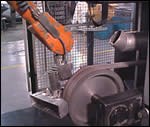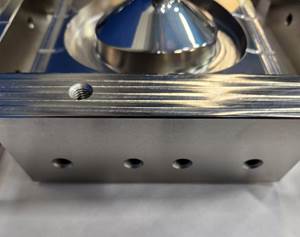Eyeing Robotics?
Thinking about automating your buffing and polishing operations? Factors such as return on investment, health and safety issues and auxiliary costs should be considered before taking the plunge.
Having been used for thousands of years, polishing and buffing are perhaps the oldest finishing processes known to man. While the fundamentals of these operations have changed very little since their inception, the industry has seen some significant advancements in the field of robotics in the past half-century.
Automation began creeping into buffing and polishing applications in the 1950s and 60s. At the time, the technology was effective only for large volumes of basic parts. More complex parts were not candidates for automation, due to the long set-up times required for multiple processing heads. However, with the passage of time, robotic cells have become more advanced, giving them a greater degree of flexibility.
Today, robotic polishing and buffing has been integrated into the manufacturing process for a number of different industries, including the medical, cookware, automotive, marine and aerospace industries.
Because the introduction of robotics into a facility is not inexpensive, it is not a decision to be taken lightly. Plant and job shop owners should consider a variety of different factors when attempting to determine whether or not a move towards robotics is justified.
Return on Investment
Perhaps the biggest issue to consider when contemplating a move towards robotics is the cost of introducing the new technology, as opposed to the short and long-term financial benefits that the job shop owner can expect to reap.
The costs of introducing automated buffing/polishing technology to a job shop can vary dramatically, depending on the number of robotic cells required, the operations that will be performed and the size and complexity of the parts being polished. A small robotic cell, employing a remanufactured robot might sell for $150,000. That cost may more than double for a larger units or one capable of handling multiple operations.
“Robotics are best suited for job shops that perform large quantity runs of parts on a consistent basis,” says Paul F. Miekstyn, senior product manager of Robotic Systems at Acme Manufacturing Co. “A lot of job shops have short runs and may have dozens of different part types. That makes the investment really difficult to justify, because you have to purchase tooling [for each part type] and you have to program each part type.”
According to Mr. Miekstyn, return on investment (ROI) is another critical factor. “If you are only running a robotic cell on one shift per day, it's going to be very hard for you to justify that investment,” he says. “One shift per day means you are going to spend a longer amount of time paying back a cell, relative to running the cell two or three shifts per day.”
Job shop owners also need to prepare themselves mentally for the purchase of a robotic cell. “The mentality of a job shop is that they don’t normally buy large pieces of capital equipment. For some shops, a $12,000 polishing lathe is a ‘large’ capital investment. A $300,000 price tag is going to leave a lot of potential buyers with sticker shock. Only very large, very successful job shops can justify the expenditure.”
Safety and Savings
“It is increasingly difficult today to be able to find young people who are willing to work as manual polishers and buffers, even though they are normally well compensated,” says Bob Penque, owner and president of Pinnacle Technologies Inc. “Manual polishing and buffing can be tedious, dirty and unhealthy jobs, and it takes a long time to train someone to be productive in hand polishing. A lot of the younger guys who take on these jobs will work for a few months and then opt to go to another part of the plant that is cleaner.”
OSHA (Occupational Health and Safety) guidelines require that human operators wear gloves, aprons, safety goggles, earplugs, leg and shin protectors and other safety items. Robotics eliminates this need, potentially saving a job shop owner hundreds or even thousands of dollars per year, per work station.
Other costs, which may be avoided via the purchase of a robotic cell, may include insurance and workers’ compensation. “This type of work has a tendency to cause repetitive motion type injuries, such as carpal tunnel syndrome,” said Mr. Penque. “Workman compensation costs are, in some cases, the primary motivation to automate.”
Because of the consistency that robots offer, the cost savings often extend into the area of supplies such as abrasive belts and buffing compounds. “With hand polishing, each worker may do the part a little bit different. When a robot is doing it, it is very consistent,” says Mr. Penque. “A robot is able to exert a consistent, uniform pressure to all parts at all times. This can result in as much as a 300-400% increase in supply life.”
Other Factors
In addition to ROI, cost savings and health and safety issues, job shops owners should ask themselves whether or not they have a legitimate need for robotics, or if they are simply attracted by the notion of going “hi-tech.” For instance, if a job shop is located in an area with a large labor market, it may be much more feasible to simply hire more hand finishers from the pool of willing candidates. Similarly, job shop owners may want to investigate the costs associated with outsourcing their buffing and polishing processes, as doing so may be a more cost-effective option than robotics.
Job shops should also be prepared for other hurdles associated with introducing robotic technology to a facility. Bringing automated technology into a job shop is not as simple as just delivering a robot. Workers—oftenwith the aid of simulation software—must “teach” the robot how to perform the polishing and buffing operations. This is a complex process, and can take as long as several days to develop a new part program. Conversely, workers must be trained to use the robotic technology and may also be required to learn how to use simulation and 3-D CAD software.
Related Content
Finishing High Reliability, Function Critical Parts
From safety critical automotive and aerospace components to lifesaving medical micro-components and implantable devices, Indiana-based Electro-Spec finishes applications that require zero failure rates.
Read MoreEngineered Coatings Offer Improvement for Medical Device Manufacturers
Diamond electroless nickel coating provides better lubricity and improved wear resistance for molds, resulting in better quality and productivity.
Read MorePrecision Coating Receives ISO 14001 Certification
The company says its commitment to the environment and its health led it to seek this certification.
Read MoreMasking Solutions for Medical Applications
According to Custom Fabricating and Supplies, a cleanroom is ideal for converting, die cutting, laminating, slitting, packaging and assembly of medical-grade products.
Read MoreRead Next
Delivering Increased Benefits to Greenhouse Films
Baystar's Borstar technology is helping customers deliver better, more reliable production methods to greenhouse agriculture.
Read MoreA ‘Clean’ Agenda Offers Unique Presentations in Chicago
The 2024 Parts Cleaning Conference, co-located with the International Manufacturing Technology Show, includes presentations by several speakers who are new to the conference and topics that have not been covered in past editions of this event.
Read MoreEducation Bringing Cleaning to Machining
Debuting new speakers and cleaning technology content during this half-day workshop co-located with IMTS 2024.
Read More


















.jpg;maxWidth=300;quality=90)








